The Foxtrot was introduced into the mainstream in 1913 by a man named Harry Fox. It ultimately became the most popular and lasting dance of the twentieth century, but not before going through many stylistic changes.
Compared with today's standards, the original Foxtrot was moderately fast, simple and unrefined, not unlike the music of the time. The popularity of the dance stemmed from its overall versatility and rhythmic variation (Foxtrot is noted for being the first dance to introduce the "Slow" count, before which time the popular dances such as the Waltz and the One-Step had only a single-count rhythm). But it wasn't until the early 30's that Foxtrot began to take on a smoother and more flowing quality in contrast to the new and exciting Latin dances hitting the scene.
A modified version called the Slow Foxtrot was evolved by the English, and is the technical basis for the version we now have.
Footwork: Forward walking steps are normally taken with the heel first in contact with the floor, with the toe lowering as the body moves over it. Backwards walks are taken with the toe first, with the heel lowering as the body moves over it. At the same time, the toe of the forward foot should release from the floor as the body moves away. Side steps and chasses normally use the toe first.
Rise & Fall The rise & fall action is present in Foxtrot, although it is more subtle than that of Waltz. In Bronze levels, there is a very slight rise & fall action on most chasses. In Silver and above levels, rise & fall is present in a more consistent 3-step cycle, yet it is still more subtle than in Waltz, owing to the continuous passing of the feet in a lengthwise manner.
Contra-Body Movement Typical of the smooth and standard ballroom dances, contra-body movement is used to commence most rotational movements.
Sway Sway is defined as the inclination of the body to the left or right, usually accompanying movements to the side. Sway is present in Foxtrot, particularly in the Silver and above levels, where movements tend to be fuller and more sweeping. In Bronze Foxtrot, a subtle sway can be used on the Chasse movements.
Continuity Continuity is defined as the continuous passing of the feet from step to step, without any closing or chasse actions. Typically, a series of three or more passing steps constitute a continuity action. Continuity movements are introduced in the Silver level of Foxtrot, and are almost entirely absent in the Bronze level. In fact, in American style dance competitions, continuity is expressly prohibited in the Bronze level.
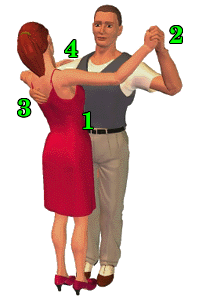 Foxtrot is danced using a normal ballroom-style closed position dance hold. This typically includes the use of body contact, although a more relaxed semi-closed hold is often used in social dance situations, or for learning purposes.
Foxtrot is danced using a normal ballroom-style closed position dance hold. This typically includes the use of body contact, although a more relaxed semi-closed hold is often used in social dance situations, or for learning purposes.
In closed position the man and lady stand in front of each other, slightly offset to the left. The lady's right hand and man's left hand are joined in an upper-hand clasp at approximately the lady's eye level. The man's right hand is placed on the lady's shoulder blade, with the lady's left arm resting easily on his right. The resulting dance "frame" should be held sturdy, but relaxed and absent of tension or strain.
For a more detailed study of closed position, see the Glossary of Dance Positions.

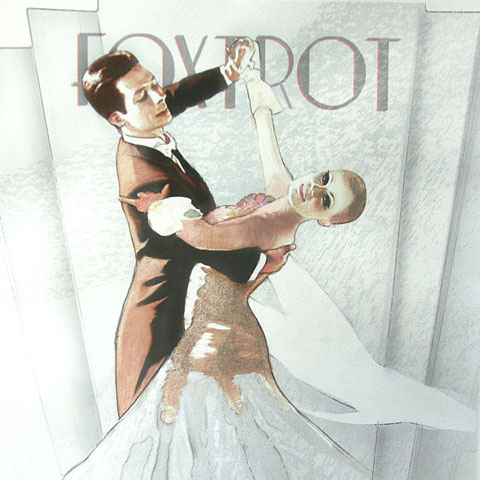
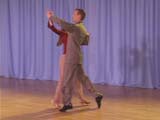 Feather Step
Feather Step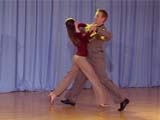 Three Step
Three Step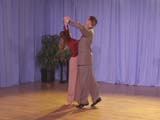 Natural Turn
Natural Turn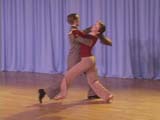 Reverse Turn and Feather Finish
Reverse Turn and Feather Finish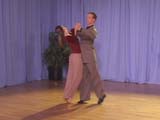 Closed Impetus and Feather Finish
Closed Impetus and Feather Finish Foxtrot is danced using a normal ballroom-style closed position dance hold. This typically includes the use of body contact, although a more relaxed semi-closed hold is often used in social dance situations, or for learning purposes.
Foxtrot is danced using a normal ballroom-style closed position dance hold. This typically includes the use of body contact, although a more relaxed semi-closed hold is often used in social dance situations, or for learning purposes.